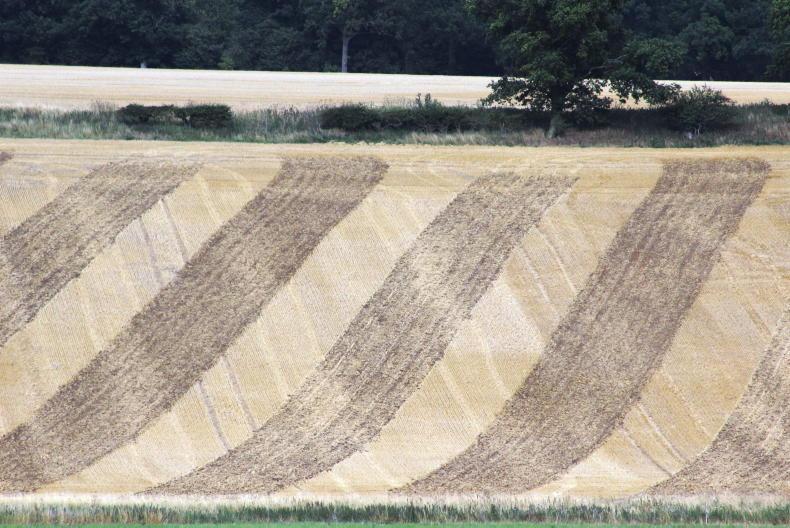The new Nitrates Action Programme (NAP) will bring about major changes on tillage farms, from slurry application to stubble cultivation. However, many details are still to be ironed out. For example, rules around stubble cultivation will be finalised in the coming weeks, as the current regulations run the risk of taking away habitats of endangered bird species.
Details are still needed on critical source areas and how they are to be identified on land where there are late harvested crops like maize and beet, while details of slurry application after the new closed period are also needed.
The most immediate of the nitrates changes involves stubble cultivation. Farmers will have to:
Shallow cultivate seven days after straw is baled or seven days after harvest and straw chopping.In all cases, shallow cultivation is to be completed within 14 days of harvest.If land is ploughed between 1 July and 30 November, efforts to establish a green cover must be made within 14 days of ploughing.It should be noted that where a winter crop is not planted, the aim is to establish a green cover, either through natural regeneration or by sowing a cover crop and this can be done by shallow cultivation or by using a direct drill.
Slurry
Farmers should be aware that from 1 January 2023, pig slurry must be applied using low emissions slurry spreading (LESS) equipment. Other slurry can be applied with a splash plate, but must be incorporated within 24 hours of application.
Under the new programme, slurry cannot be spread after 8 October in 2022 and 1 October in 2023.
However, the document does state that under certain circumstances farmers will be allowed to apply slurry up to 15 October. The scientific criteria for this allowance is due to be published by 1 September 2022 and will have to be strictly met.
Many tillage farmers use slurry in October on land destined for winter crops. Best advice on sowing winter crops is to delay sowing into October.
If slurry is to be applied and incorporated ahead of sowing, these dates won’t match up and a sustainable method of P and K build up will be lost.
We must also remember that their tanks may be full and in order to allow animals in for winter, then winter crops are the best option for applying that slurry.
Chemical fertiliser
The closed period for applying chemical fertiliser will be extended by 14 days in zones A, B and C. The chemical fertiliser register will come into effect in 2023. Farmers should also remember that a slurry movement register is now in place.
Buffer zones
The new programme states that a 6m buffer zone will need to be placed in critical source areas, which will have to be identified, in late-harvested crops such as potatoes, maize and late-harvested spring cereals.
*Clarification on stubble cultivation is due soon and farmers should watch for updates.
The new Nitrates Action Programme (NAP) will bring about major changes on tillage farms, from slurry application to stubble cultivation. However, many details are still to be ironed out. For example, rules around stubble cultivation will be finalised in the coming weeks, as the current regulations run the risk of taking away habitats of endangered bird species.
Details are still needed on critical source areas and how they are to be identified on land where there are late harvested crops like maize and beet, while details of slurry application after the new closed period are also needed.
The most immediate of the nitrates changes involves stubble cultivation. Farmers will have to:
Shallow cultivate seven days after straw is baled or seven days after harvest and straw chopping.In all cases, shallow cultivation is to be completed within 14 days of harvest.If land is ploughed between 1 July and 30 November, efforts to establish a green cover must be made within 14 days of ploughing.It should be noted that where a winter crop is not planted, the aim is to establish a green cover, either through natural regeneration or by sowing a cover crop and this can be done by shallow cultivation or by using a direct drill.
Slurry
Farmers should be aware that from 1 January 2023, pig slurry must be applied using low emissions slurry spreading (LESS) equipment. Other slurry can be applied with a splash plate, but must be incorporated within 24 hours of application.
Under the new programme, slurry cannot be spread after 8 October in 2022 and 1 October in 2023.
However, the document does state that under certain circumstances farmers will be allowed to apply slurry up to 15 October. The scientific criteria for this allowance is due to be published by 1 September 2022 and will have to be strictly met.
Many tillage farmers use slurry in October on land destined for winter crops. Best advice on sowing winter crops is to delay sowing into October.
If slurry is to be applied and incorporated ahead of sowing, these dates won’t match up and a sustainable method of P and K build up will be lost.
We must also remember that their tanks may be full and in order to allow animals in for winter, then winter crops are the best option for applying that slurry.
Chemical fertiliser
The closed period for applying chemical fertiliser will be extended by 14 days in zones A, B and C. The chemical fertiliser register will come into effect in 2023. Farmers should also remember that a slurry movement register is now in place.
Buffer zones
The new programme states that a 6m buffer zone will need to be placed in critical source areas, which will have to be identified, in late-harvested crops such as potatoes, maize and late-harvested spring cereals.
*Clarification on stubble cultivation is due soon and farmers should watch for updates.






 This is a subscriber-only article
This is a subscriber-only article











SHARING OPTIONS: